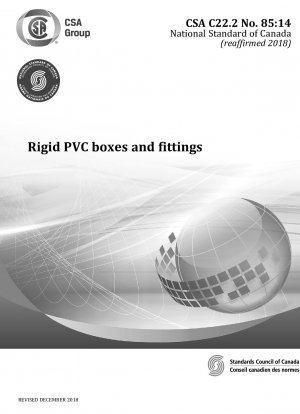CSA C22.2 No.85-2014(R2018)
Rigid PVC boxes and fittings
- Standard No.
- CSA C22.2 No.85-2014(R2018)
- Release Date
- 1970
- Published By
- /
- Latest
- CSA C22.2 No.85-2014(R2018)
- Scope
- Scope 1.1 This Standard applies to rigid unplasticized poly (vinyl chloride)* boxes and fittings of the following types that are intended to be installed and used with rigid PVC conduit at a maximum working temperature of 75 °C in accordance with the rules of the Canadian Electrical Code, Part I: a) junction boxes with an interior volume of 1640 mL+ or less that are intended to provide access to wiring and to enclose splices and taps but not to support wiring devices; b) conduit boxes with an interior volume of 1640 mL+ or less that are intended to be used as pull boxes but not to enclose splices and taps or support wiring devices; c) surface mounted device boxes with an interior volume of 1640 mL+ or less that are intended primarily to support wiring devices but may also be used as a pull box or to enclose wiring joints; d) box covers of the blank and device types; e) expansion joints that are intended to compensate for the linear expansion of a span of rigid PVC conduit; f) junction box terminal adapters that are intended to connect a length of PVC conduit by an elbow or other bend to a box; g) female adapters that are intended to connect a length of PVC conduit to a length of rigid metal conduit; h) reducers that are intended to connect lengths of two different sizes of rigid PVC conduit; i) caps that are intended to close the ends of unused lengths of rigid PVC conduit; and j) bell ends that are intended to provide a bushed opening at the open end of a length of rigid PVC conduit. * For convenience, the shorter term PVC is used in this Standard. + 1640 mL is the volume of trade size known as 100 cubic inches. 1.2 General requirements applicable to this Standard are given in CSA C22.2 No. 0, General Requirements - Canadian Electrical Code, Part II. 1.3 In this Standard, "shall" is used to express a requirement, i.e., a provision that the user is obliged to satisfy in order to comply with the standard; "should" is used to express a recommendation or that which is advised but not required; and "may" is used to express an option or that which is permissible within the limits of the standard. Notes accompanying clauses do not include requirements or alternative requirements; the purpose of a note accompanying a clause is to separate from the text explanatory or informative material. Notes to tables and figures are considered part of the table or figure and may be written as requirements. Annexes are designated normative (mandatory) or informative (nonmandatory) to define their application.
CSA C22.2 No.85-2014(R2018) history
- 2014 CSA C22.2 NO.85-2014 Rigid PVC boxes and fittings (Second Edition)
- 1968 CSA C22.2 No.85-1968 Rigid PVC Boxes and Fittings
